Filipino vs Estonian Community Comparison
COMPARE
Filipino
Estonian
Social Comparison
Social Comparison
Filipinos
Estonians
9,951
SOCIAL INDEX
97.0/ 100
SOCIAL RATING
5th/ 347
SOCIAL RANK
8,730
SOCIAL INDEX
84.8/ 100
SOCIAL RATING
54th/ 347
SOCIAL RANK
Estonian Integration in Filipino Communities
The statistical analysis conducted on geographies consisting of 98,205,843 people shows a moderate positive correlation between the proportion of Estonians within Filipino communities in the United States with a correlation coefficient (R) of 0.441. On average, for every 1% (one percent) increase in Filipinos within a typical geography, there is an increase of 0.026% in Estonians. To illustrate, in a geography comprising of 100,000 individuals, a rise of 1,000 Filipinos corresponds to an increase of 26.0 Estonians.
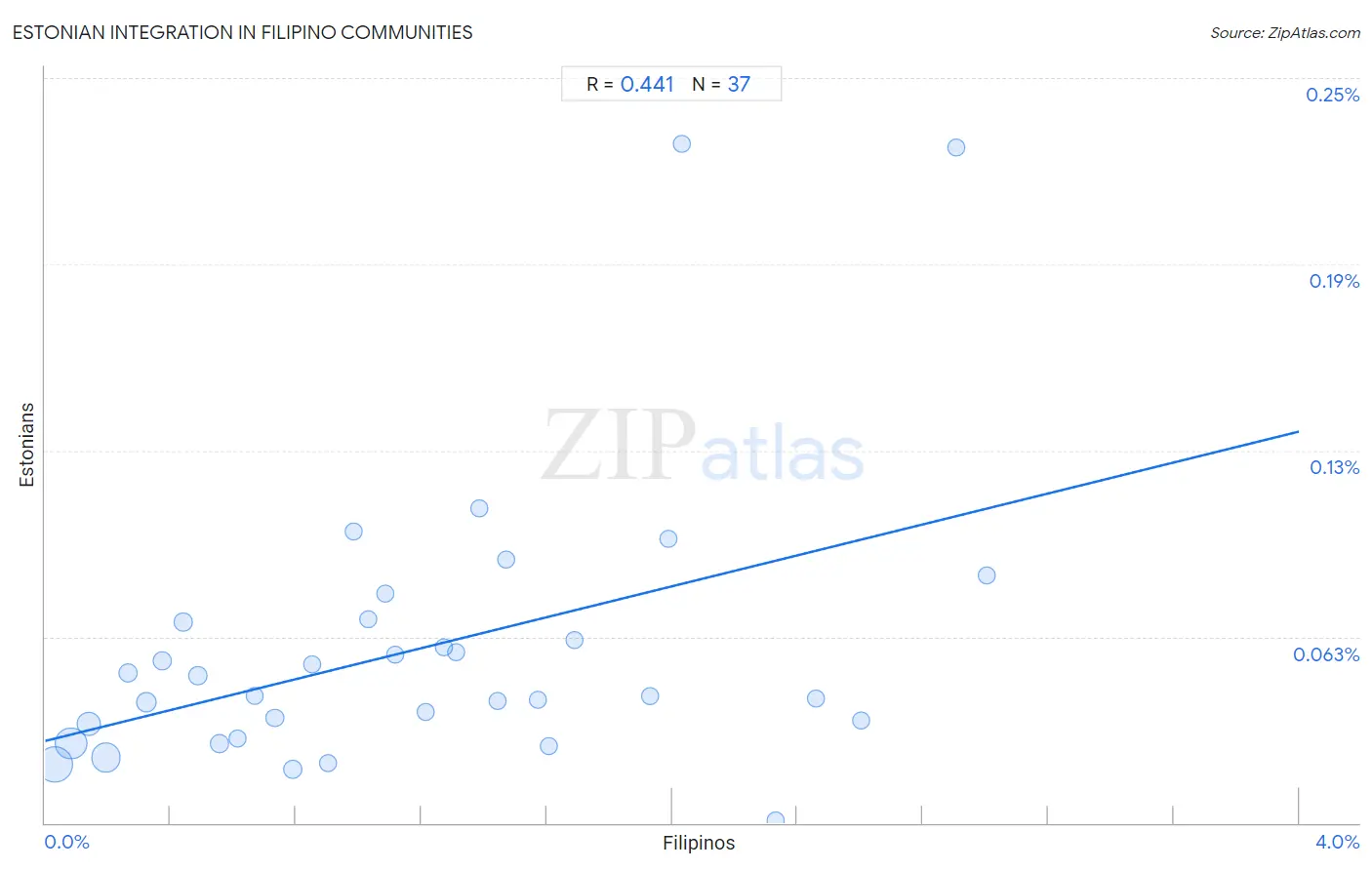
Filipino vs Estonian Income
When considering income, the most significant differences between Filipino and Estonian communities in the United States are seen in median household income ($115,509 compared to $95,930, a difference of 20.4%), median male earnings ($74,224 compared to $61,710, a difference of 20.3%), and householder income ages 25 - 44 years ($128,723 compared to $107,269, a difference of 20.0%). Conversely, both communities are more comparable in terms of wage/income gap (29.7% compared to 27.1%, a difference of 9.7%), householder income under 25 years ($57,740 compared to $51,523, a difference of 12.1%), and householder income over 65 years ($76,686 compared to $67,926, a difference of 12.9%).

| Income Metric | Filipino | Estonian |
| Per Capita Income | Exceptional $59,066 | Exceptional $51,875 |
| Median Family Income | Exceptional $138,397 | Exceptional $118,013 |
| Median Household Income | Exceptional $115,509 | Exceptional $95,930 |
| Median Earnings | Exceptional $61,197 | Exceptional $51,772 |
| Median Male Earnings | Exceptional $74,224 | Exceptional $61,710 |
| Median Female Earnings | Exceptional $49,508 | Exceptional $43,106 |
| Householder Age | Under 25 years | Exceptional $57,740 | Poor $51,523 |
| Householder Age | 25 - 44 years | Exceptional $128,723 | Exceptional $107,269 |
| Householder Age | 45 - 64 years | Exceptional $134,910 | Exceptional $114,220 |
| Householder Age | Over 65 years | Exceptional $76,686 | Exceptional $67,926 |
| Wage/Income Gap | Tragic 29.7% | Tragic 27.1% |
Filipino vs Estonian Poverty
When considering poverty, the most significant differences between Filipino and Estonian communities in the United States are seen in receiving food stamps (7.4% compared to 9.5%, a difference of 28.3%), child poverty under the age of 5 (11.6% compared to 14.8%, a difference of 27.6%), and child poverty among boys under 16 (11.1% compared to 14.1%, a difference of 26.4%). Conversely, both communities are more comparable in terms of seniors poverty over the age of 75 (11.4% compared to 11.4%, a difference of 0.69%), seniors poverty over the age of 65 (9.7% compared to 9.6%, a difference of 1.0%), and married-couple family poverty (4.0% compared to 4.2%, a difference of 3.2%).
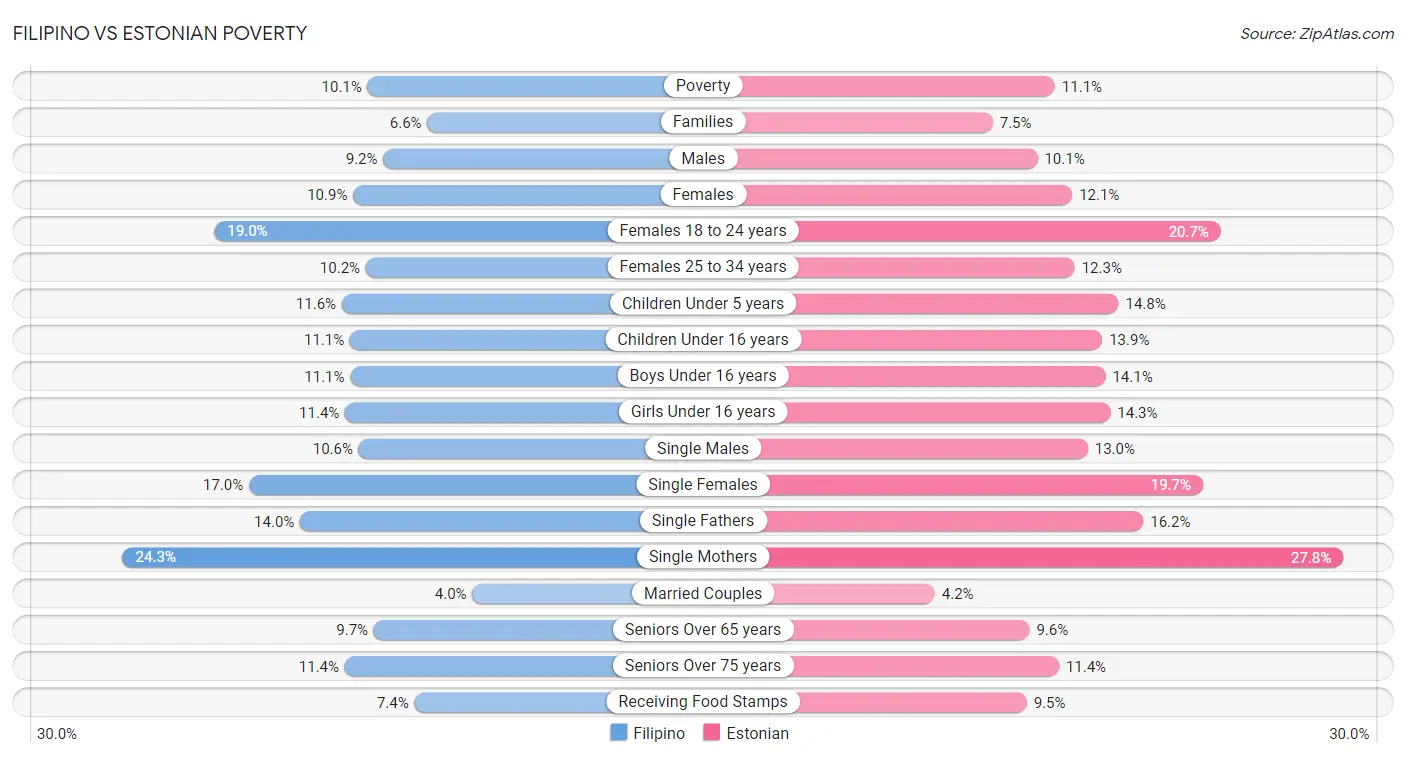
| Poverty Metric | Filipino | Estonian |
| Poverty | Exceptional 10.1% | Exceptional 11.1% |
| Families | Exceptional 6.6% | Exceptional 7.5% |
| Males | Exceptional 9.2% | Exceptional 10.1% |
| Females | Exceptional 10.9% | Exceptional 12.1% |
| Females 18 to 24 years | Exceptional 19.0% | Tragic 20.7% |
| Females 25 to 34 years | Exceptional 10.2% | Exceptional 12.3% |
| Children Under 5 years | Exceptional 11.6% | Exceptional 14.8% |
| Children Under 16 years | Exceptional 11.1% | Exceptional 13.9% |
| Boys Under 16 years | Exceptional 11.1% | Exceptional 14.1% |
| Girls Under 16 years | Exceptional 11.4% | Exceptional 14.3% |
| Single Males | Exceptional 10.6% | Fair 13.0% |
| Single Females | Exceptional 17.0% | Exceptional 19.7% |
| Single Fathers | Exceptional 14.0% | Average 16.2% |
| Single Mothers | Exceptional 24.3% | Exceptional 27.8% |
| Married Couples | Exceptional 4.0% | Exceptional 4.2% |
| Seniors Over 65 years | Exceptional 9.7% | Exceptional 9.6% |
| Seniors Over 75 years | Exceptional 11.4% | Exceptional 11.4% |
| Receiving Food Stamps | Exceptional 7.4% | Exceptional 9.5% |
Filipino vs Estonian Unemployment
When considering unemployment, the most significant differences between Filipino and Estonian communities in the United States are seen in unemployment among women with children ages 6 to 17 years (7.6% compared to 9.3%, a difference of 22.3%), unemployment among women with children under 6 years (6.1% compared to 7.1%, a difference of 15.2%), and unemployment among seniors over 75 years (7.9% compared to 8.8%, a difference of 12.0%). Conversely, both communities are more comparable in terms of unemployment among ages 65 to 74 years (5.2% compared to 5.2%, a difference of 0.020%), unemployment among seniors over 65 years (5.0% compared to 5.0%, a difference of 0.070%), and unemployment among youth under 25 years (11.1% compared to 11.3%, a difference of 1.3%).
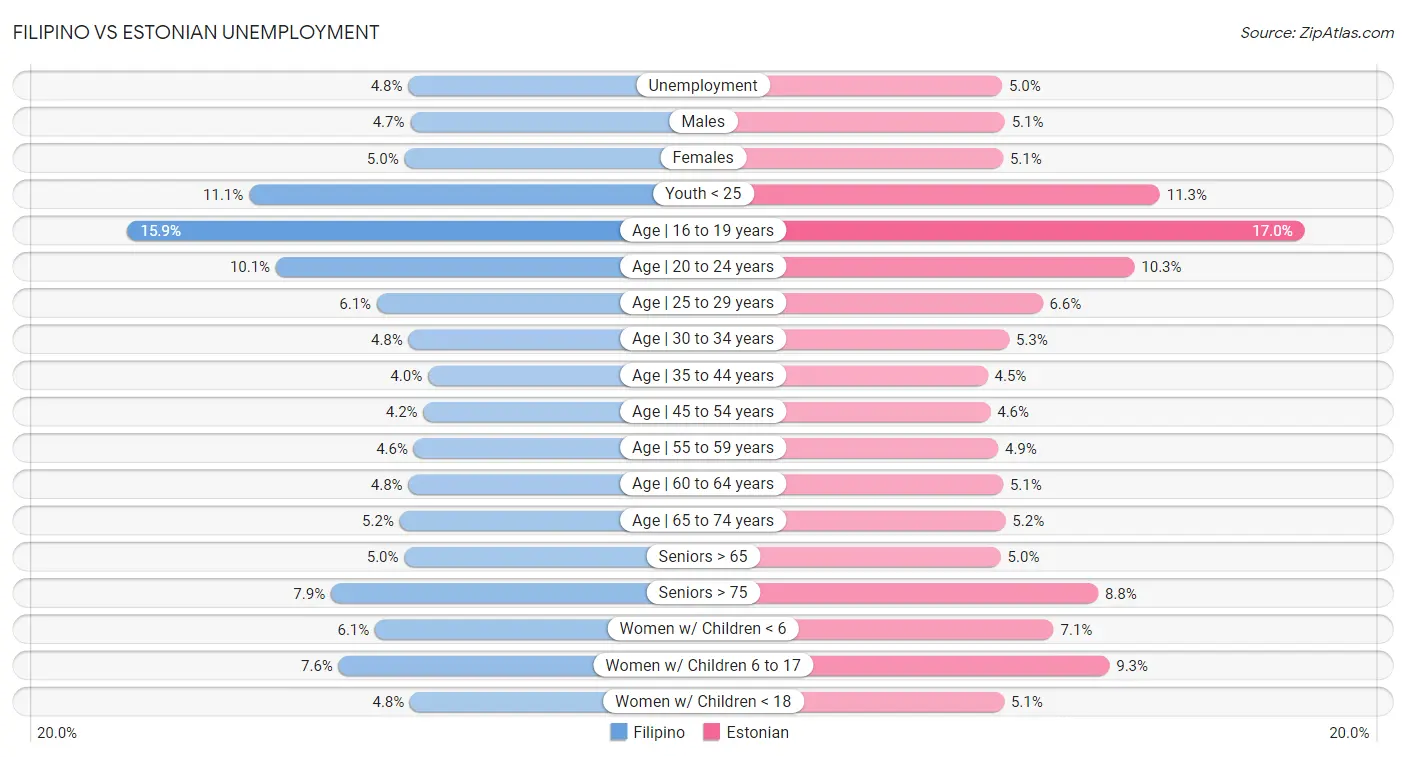
| Unemployment Metric | Filipino | Estonian |
| Unemployment | Exceptional 4.8% | Exceptional 5.0% |
| Males | Exceptional 4.7% | Excellent 5.1% |
| Females | Exceptional 5.0% | Exceptional 5.1% |
| Youth < 25 | Exceptional 11.1% | Exceptional 11.3% |
| Age | 16 to 19 years | Exceptional 15.9% | Exceptional 17.0% |
| Age | 20 to 24 years | Exceptional 10.1% | Good 10.3% |
| Age | 25 to 29 years | Exceptional 6.1% | Average 6.6% |
| Age | 30 to 34 years | Exceptional 4.8% | Excellent 5.3% |
| Age | 35 to 44 years | Exceptional 4.0% | Exceptional 4.5% |
| Age | 45 to 54 years | Exceptional 4.2% | Fair 4.6% |
| Age | 55 to 59 years | Exceptional 4.6% | Fair 4.9% |
| Age | 60 to 64 years | Good 4.8% | Tragic 5.1% |
| Age | 65 to 74 years | Exceptional 5.2% | Exceptional 5.2% |
| Seniors > 65 | Exceptional 5.0% | Exceptional 5.0% |
| Seniors > 75 | Exceptional 7.9% | Fair 8.8% |
| Women w/ Children < 6 | Exceptional 6.1% | Exceptional 7.1% |
| Women w/ Children 6 to 17 | Exceptional 7.6% | Tragic 9.3% |
| Women w/ Children < 18 | Exceptional 4.8% | Exceptional 5.1% |
Filipino vs Estonian Labor Participation
When considering labor participation, the most significant differences between Filipino and Estonian communities in the United States are seen in in labor force | age 16-19 (31.7% compared to 37.7%, a difference of 18.9%), in labor force | age 20-24 (71.4% compared to 75.6%, a difference of 5.9%), and in labor force | age > 16 (65.9% compared to 64.8%, a difference of 1.8%). Conversely, both communities are more comparable in terms of in labor force | age 20-64 (80.1% compared to 80.0%, a difference of 0.060%), in labor force | age 45-54 (83.5% compared to 83.4%, a difference of 0.13%), and in labor force | age 30-34 (85.5% compared to 85.9%, a difference of 0.49%).

| Labor Participation Metric | Filipino | Estonian |
| In Labor Force | Age > 16 | Exceptional 65.9% | Poor 64.8% |
| In Labor Force | Age 20-64 | Exceptional 80.1% | Exceptional 80.0% |
| In Labor Force | Age 16-19 | Tragic 31.7% | Exceptional 37.7% |
| In Labor Force | Age 20-24 | Tragic 71.4% | Excellent 75.6% |
| In Labor Force | Age 25-29 | Excellent 84.9% | Exceptional 85.5% |
| In Labor Force | Age 30-34 | Exceptional 85.5% | Exceptional 85.9% |
| In Labor Force | Age 35-44 | Exceptional 84.7% | Exceptional 85.3% |
| In Labor Force | Age 45-54 | Exceptional 83.5% | Exceptional 83.4% |
Filipino vs Estonian Family Structure
When considering family structure, the most significant differences between Filipino and Estonian communities in the United States are seen in births to unmarried women (23.0% compared to 29.2%, a difference of 27.1%), divorced or separated (9.9% compared to 11.7%, a difference of 18.1%), and single father households (1.8% compared to 2.1%, a difference of 15.6%). Conversely, both communities are more comparable in terms of average family size (3.20 compared to 3.10, a difference of 3.1%), currently married (49.7% compared to 48.2%, a difference of 3.2%), and family households (65.9% compared to 62.9%, a difference of 4.8%).

| Family Structure Metric | Filipino | Estonian |
| Family Households | Exceptional 65.9% | Tragic 62.9% |
| Family Households with Children | Exceptional 28.6% | Tragic 26.1% |
| Married-couple Households | Exceptional 51.0% | Exceptional 47.7% |
| Average Family Size | Poor 3.20 | Tragic 3.10 |
| Single Father Households | Exceptional 1.8% | Exceptional 2.1% |
| Single Mother Households | Exceptional 4.7% | Exceptional 5.4% |
| Currently Married | Exceptional 49.7% | Exceptional 48.2% |
| Divorced or Separated | Exceptional 9.9% | Exceptional 11.7% |
| Births to Unmarried Women | Exceptional 23.0% | Exceptional 29.2% |
Filipino vs Estonian Vehicle Availability
When considering vehicle availability, the most significant differences between Filipino and Estonian communities in the United States are seen in 4 or more vehicles in household (6.9% compared to 6.4%, a difference of 8.8%), no vehicles in household (10.4% compared to 9.8%, a difference of 6.0%), and 3 or more vehicles in household (20.8% compared to 19.7%, a difference of 5.5%). Conversely, both communities are more comparable in terms of 1 or more vehicles in household (89.7% compared to 90.3%, a difference of 0.69%), 2 or more vehicles in household (57.8% compared to 56.6%, a difference of 2.1%), and 3 or more vehicles in household (20.8% compared to 19.7%, a difference of 5.5%).

| Vehicle Availability Metric | Filipino | Estonian |
| No Vehicles Available | Average 10.4% | Excellent 9.8% |
| 1+ Vehicles Available | Average 89.7% | Excellent 90.3% |
| 2+ Vehicles Available | Exceptional 57.8% | Exceptional 56.6% |
| 3+ Vehicles Available | Exceptional 20.8% | Good 19.7% |
| 4+ Vehicles Available | Exceptional 6.9% | Average 6.4% |
Filipino vs Estonian Education Level
When considering education level, the most significant differences between Filipino and Estonian communities in the United States are seen in doctorate degree (3.4% compared to 2.5%, a difference of 35.9%), professional degree (7.6% compared to 6.0%, a difference of 27.0%), and master's degree (23.4% compared to 18.8%, a difference of 24.6%). Conversely, both communities are more comparable in terms of high school diploma (91.6% compared to 91.6%, a difference of 0.010%), 12th grade, no diploma (93.2% compared to 93.2%, a difference of 0.030%), and 11th grade (94.1% compared to 94.4%, a difference of 0.30%).
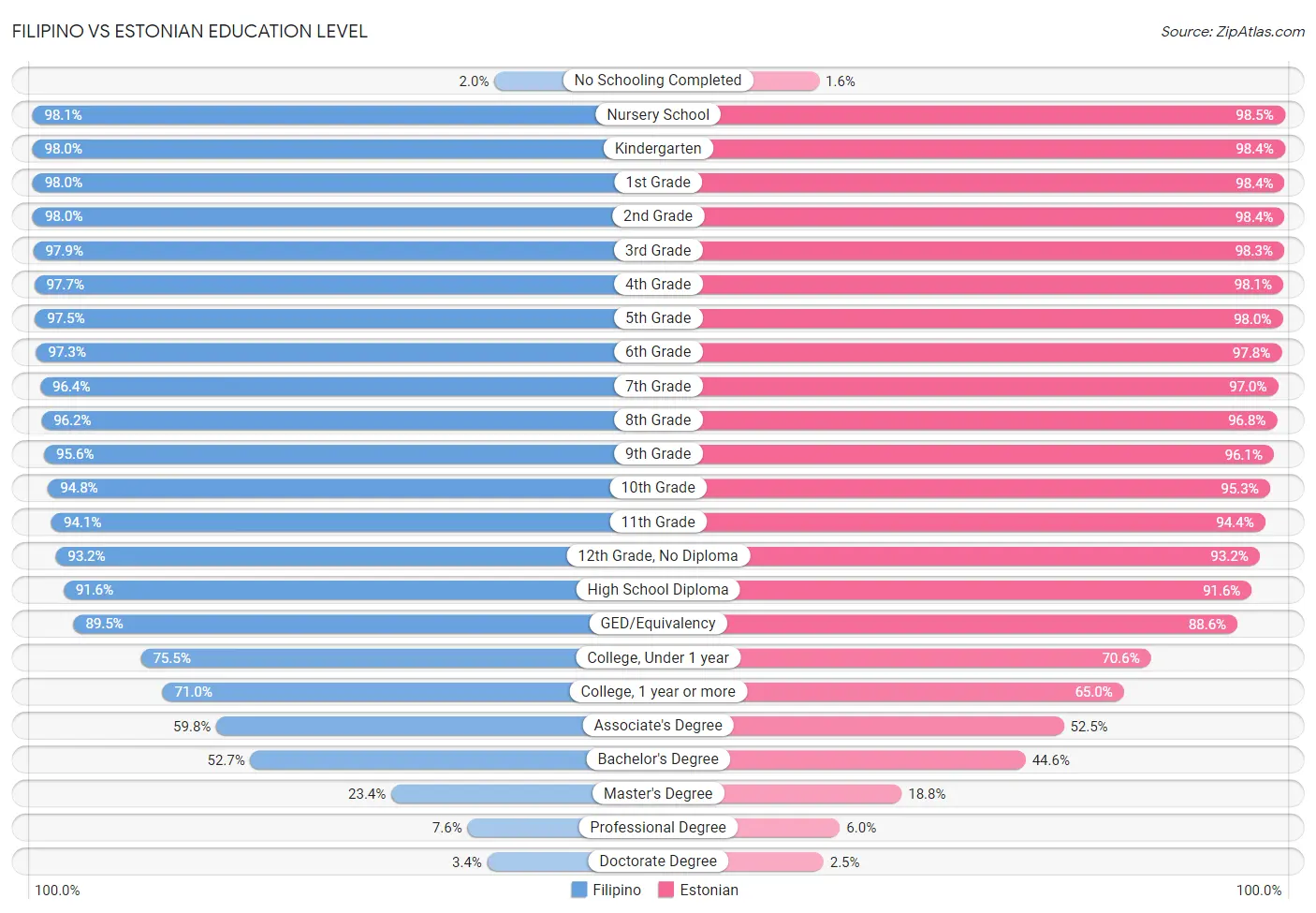
| Education Level Metric | Filipino | Estonian |
| No Schooling Completed | Excellent 2.0% | Exceptional 1.6% |
| Nursery School | Good 98.1% | Exceptional 98.5% |
| Kindergarten | Good 98.0% | Exceptional 98.4% |
| 1st Grade | Good 98.0% | Exceptional 98.4% |
| 2nd Grade | Good 98.0% | Exceptional 98.4% |
| 3rd Grade | Good 97.9% | Exceptional 98.3% |
| 4th Grade | Excellent 97.7% | Exceptional 98.1% |
| 5th Grade | Excellent 97.5% | Exceptional 98.0% |
| 6th Grade | Excellent 97.3% | Exceptional 97.8% |
| 7th Grade | Exceptional 96.4% | Exceptional 97.0% |
| 8th Grade | Exceptional 96.2% | Exceptional 96.8% |
| 9th Grade | Exceptional 95.6% | Exceptional 96.1% |
| 10th Grade | Exceptional 94.8% | Exceptional 95.3% |
| 11th Grade | Exceptional 94.1% | Exceptional 94.4% |
| 12th Grade, No Diploma | Exceptional 93.2% | Exceptional 93.2% |
| High School Diploma | Exceptional 91.6% | Exceptional 91.6% |
| GED/Equivalency | Exceptional 89.5% | Exceptional 88.6% |
| College, Under 1 year | Exceptional 75.5% | Exceptional 70.6% |
| College, 1 year or more | Exceptional 71.0% | Exceptional 65.0% |
| Associate's Degree | Exceptional 59.8% | Exceptional 52.5% |
| Bachelor's Degree | Exceptional 52.7% | Exceptional 44.6% |
| Master's Degree | Exceptional 23.4% | Exceptional 18.8% |
| Professional Degree | Exceptional 7.6% | Exceptional 6.0% |
| Doctorate Degree | Exceptional 3.4% | Exceptional 2.5% |
Filipino vs Estonian Disability
When considering disability, the most significant differences between Filipino and Estonian communities in the United States are seen in disability age under 5 (1.1% compared to 1.5%, a difference of 46.9%), disability age 35 to 64 (8.0% compared to 10.6%, a difference of 32.0%), and disability age 5 to 17 (4.3% compared to 5.5%, a difference of 26.8%). Conversely, both communities are more comparable in terms of disability age over 75 (45.4% compared to 45.6%, a difference of 0.37%), cognitive disability (16.4% compared to 16.7%, a difference of 1.7%), and self-care disability (2.2% compared to 2.3%, a difference of 8.9%).
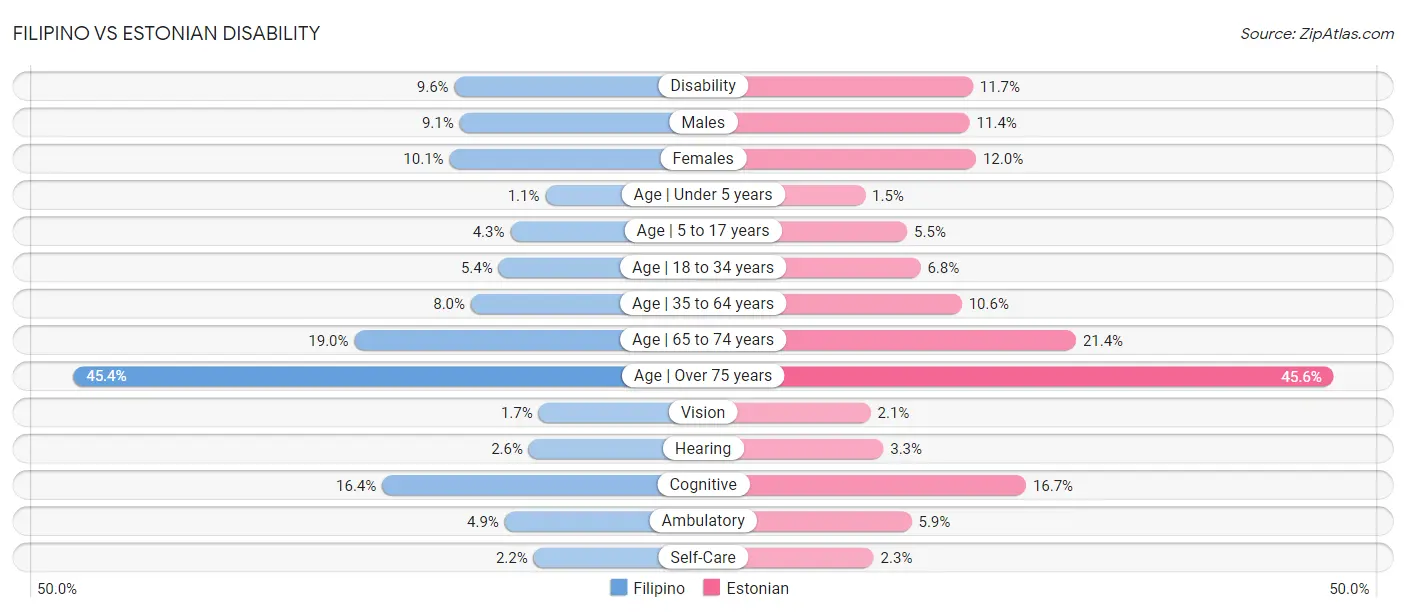
| Disability Metric | Filipino | Estonian |
| Disability | Exceptional 9.6% | Average 11.7% |
| Males | Exceptional 9.1% | Fair 11.4% |
| Females | Exceptional 10.1% | Excellent 12.0% |
| Age | Under 5 years | Exceptional 1.1% | Tragic 1.5% |
| Age | 5 to 17 years | Exceptional 4.3% | Excellent 5.5% |
| Age | 18 to 34 years | Exceptional 5.4% | Fair 6.8% |
| Age | 35 to 64 years | Exceptional 8.0% | Exceptional 10.6% |
| Age | 65 to 74 years | Exceptional 19.0% | Exceptional 21.4% |
| Age | Over 75 years | Exceptional 45.4% | Exceptional 45.6% |
| Vision | Exceptional 1.7% | Exceptional 2.1% |
| Hearing | Exceptional 2.6% | Tragic 3.3% |
| Cognitive | Exceptional 16.4% | Exceptional 16.7% |
| Ambulatory | Exceptional 4.9% | Exceptional 5.9% |
| Self-Care | Exceptional 2.2% | Exceptional 2.3% |